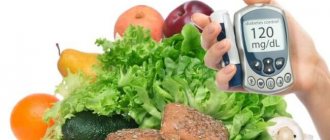Synthetic hypoglycemic oral antidiabetic agents are medications whose main function is to normalize blood glucose levels and alleviate the condition of patients with diabetes.
They achieve this in two ways: either they promote increased production of insulin by the pancreas, or they increase the sensitivity of tissues to this hormone. In addition, with such a diagnosis, additional medications are often prescribed to reduce the symptoms and consequences of the disease (to normalize blood pressure and weight, cleanse blood vessels, etc.).
Which tablets the attending physician prescribes depends on two factors: the type of diabetes and its clinical picture.
Tablets to lower blood sugar levels.
September 28, 2021
13402
4.4
8
Content
- Types of diabetes
- Causes of type 2 diabetes mellitus
- How to choose diabetes pills
- Top 5 diabetes pills
- Diabetes
- Siofor
- Januvia
- NovoNorm
- Glucobay
To treat diabetes, it is not necessary to regularly inject insulin. In many cases, it is enough to simply lead a healthy lifestyle and take special medications. Let's figure out what types of diabetes there are and what pills doctors prescribe.
Diabetes mellitus is not one specific disease, but a group of diseases in which the metabolism in the body is disrupted (in particular, carbohydrate metabolism suffers).
Types of diabetes
There are several types of diabetes.
- Diabetes mellitus type 1.
Usually this disease develops at a young age (up to 30-35 years). A feature of this type of diabetes is insulin dependence. Symptoms of type 1 diabetes: increased appetite, but weight loss against this background, frequent urination, constant thirst. With this type of diabetes, carbohydrate metabolism is impaired, and the pancreas produces too little insulin. - Diabetes mellitus type 2.
This diabetes is non-insulin dependent. Most often, the disease develops in old age. Type 2 diabetes is often inherited. This kind of diabetes requires a special diet, physical activity (moderate) and strict adherence to the advice of your doctor. - Gestational diabetes.
This type of diabetes occurs in pregnant women and usually goes away after childbirth. Sometimes gestational diabetes can negatively affect the fetus or recur after a few years. - MODY-diabetes.
This kind of diabetes is rare; the disease occurs in 5% of diabetics. Develops at an early age. In MODY diabetes, a person has a very low need for insulin. The disease is considered an intermediate stage because it has features of the first two types of diabetes.
Treatment of diabetes depends on what caused it, how severe the disease is, what chronic diseases the person has, and what his age is. Tablets for diabetes, taking into account all the above factors, can only be prescribed by a doctor.
Drugs that can provoke hyperglycemia
Corticosteroids
Glucocorticosteroids can antagonize the action of insulin and stimulate gluconeogenesis, especially in the liver, leading to an overall increase in glucose production [1]. With normal carbohydrate metabolism, this property of steroids is not accompanied by changes in glycemia: the beta cells of the pancreas are able to produce sufficient amounts of insulin to compensate for excess glucose. However, in diabetes mellitus, when insulin levels are reduced and tissue sensitivity to it is impaired, the body is not able to neutralize the effect of steroids on glucose metabolism. Therefore, while taking corticosteroids with concomitant hyperglycemia in patients with diabetes or prediabetes (impaired glucose tolerance), blood glucose levels may increase and the need for insulin or oral antidiabetic drugs may increase [1, 2].
The severity of the hyperglycemic effect varies among corticosteroids, with prednisolone and dexamethasone having the most potent effects. However, there are limitations to systemic administration of most steroids [3].
Restrictions:
- Prednisolone, methylprednisolone, dexamethasone and betamethasone are contraindicated for use in diabetes mellitus
- Hydrocortisone is prohibited for decompensated severe diabetes
- Triamcinolone is approved for disorders of carbohydrate metabolism, however, the instructions for use emphasize the likelihood of developing diabetes mellitus while taking the drug [3].
Atypical antipsychotic drugs
Drugs in this group are quite widely used to treat schizophrenia and more common mental disorders, such as recurrent depression. They can exhibit a number of serious side effects, including impaired glucose metabolism. Its severity can be so great that while taking antipsychotics, there is a possibility of developing diabetes mellitus or even diabetic ketoacidosis [1].
It is believed that hyperglycemia while taking antipsychotics develops due to changes in the regulation of glucose and insulin levels, as well as disorders of lipid metabolism. The ability of drugs in this group to stimulate appetite and promote weight gain plays a certain role. With increasing weight, the volume of adipose tissue sharply increases, which leads to a decrease in insulin sensitivity and, as a consequence, to the development of diabetes mellitus [4]. It is known that with every kilogram of excess weight, the risk of type 2 diabetes increases by 4.5% [4].
It should be noted that the severity of the negative effect of atypical antipsychotics on carbohydrate metabolism varies. Olanzapine is associated with the highest risk of impaired glycemia. Risperidone and quetiapine are considered “intermediate” risk drugs, and aripiprazole and ziprasidone have the least effect on carbohydrate metabolism [2, 4].
Restrictions
Olanzapine is prescribed with caution in diabetes mellitus. Other atypical antipsychotics, including clozapine, are used without restrictions according to the instructions [3].
Thiazide diuretics
Thiazide (hydrochlorothiazide) and thiazide-like diuretics are widely used to treat arterial hypertension, including in patients with diabetes mellitus. They are prescribed despite the fact that these drugs contribute to the development of hyperglycemia, and in some cases even induce the development of new cases of diabetes mellitus [1].
Hyperglycemia while taking diuretics of this group develops due to the implementation of several mechanisms. First, the drugs cause hypokalemia, which increases transport across beta cell membranes, leading to impaired insulin secretion. Secondly, against the background of their intake, the renin-angiotensin-aldosterone system is activated and, as a result, blood flow in the striated muscles worsens and glucose utilization decreases. This contributes to hyperglycemia and increased insulin resistance [1].
However, there is some good news. Firstly, the effect of drugs of this series on the level of glycemia is dose-dependent, and for the treatment of arterial hypertension they are used in low dosages. And secondly, the thiazide-like diuretic indapamide has virtually no negative effect on glucose metabolism, and its use in diabetes mellitus reduces the likelihood of hyperglycemia to zero [1].
Restrictions
- Hydrochlorothiazide - contraindicated in diabetes mellitus
- Chlorthalidone - contraindicated in severe forms of diabetes mellitus
- Indapamide - used with restrictions for diabetes mellitus in the stage of decompensation. The importance of monitoring blood glucose concentrations in all patients with diabetes, especially in the presence of hypokalemia, is emphasized [3].
Statins
Statins are key drugs used to prevent cardiovascular diseases. Undoubtedly, they are prescribed for diabetes, despite their so-called diabetogenic effect. Research results indicate that statins can cause the development of diabetes. However, the hyperglycemic effect of statins is quite “modest”: for the development of one case of diabetes mellitus, it is necessary to treat 167 patients with rosuvastatin at a dose of 20 mg for 5 years [1].
The negative effect on glucose levels and the possibility of increased glycemia during use are already included in the instructions for the use of statins [1]. Unfortunately, this side effect is characteristic of the entire class of drugs, and there is no difference in the severity of the hyperglycemic effect among its different representatives.
The mechanism of development of the diabetogenic effect of statins is combined. The drugs suppress insulin secretion by reducing the sensitivity of beta cells to glucose and reduce insulin sensitivity in muscles. The diabetogenic effect of statins is dose dependent: the risk of developing diabetes increases with increasing dosages.
It is noteworthy that the likelihood of diabetes when taking lipid-lowering drugs of the statin group is not increased in all consumers. The risk of a hyperglycemic effect is much higher with increased blood glucose levels, increased triglycerides, obesity (BMI ≥30 kg/m2), hypertension and old age. The increased risk of statin-induced diabetes is also associated with a number of other factors, including the female gender of the patient [1].
Despite the proven diabetogenic effect, statins continue to be used in patients with diabetes, since it is obvious that the risk of developing diabetes while taking them is completely offset by the benefit - a significant reduction in the likelihood of developing cardiovascular diseases and complications.
Restrictions
There is no guidance on the use of statins for diabetes, but the instructions emphasize the possibility of developing type 2 diabetes mellitus while taking the drugs [3].
A nicotinic acid
Vitamin PP, or niacin, is involved in many redox reactions, the formation of enzymes, and the metabolism of lipids and carbohydrates in cells. The drug is converted in the body into nicotinamide, which is involved in the metabolism of fats, proteins, amino acids, purines, tissue respiration and biosynthesis processes.
The negative effect on glycemia is expressed in the ability to increase the level of plasma glucose and glycated hemoglobin due to the development of insulin resistance and a decrease in insulin secretion by pancreatic beta cells [1]. For a person suffering from diabetes, this effect can be critical.
Restrictions
If you have diabetes, it is prohibited to take nicotinic acid in high doses. It is also considered inappropriate to prescribe a drug for the correction of dyslipidemia in cases of impaired carbohydrate metabolism. The instructions also note that nicotinic acid can reduce the hypoglycemic effect of glucose-lowering drugs [3].
Causes of type 2 diabetes mellitus
There are certain factors that influence the occurrence of diabetes.
Some metabolic disorders in the body can increase the risk of disease. Among them:
- presence of type 2 diabetes in close relatives;
- obesity or overweight;
- poor nutrition, an abundance of fatty or too carbohydrate foods in the diet;
- lack of physical activity, sedentary lifestyle;
- age factor;
- high blood pressure;
- impaired glucose tolerance (slight increase in blood sugar);
- gestational diabetes in the past;
- malnutrition during pregnancy.
In recent decades, due to changes in diet and physical activity, urbanization and the fast pace of life, the number of people with type 2 diabetes has increased sharply.
Types 1 and 2 diabetes: differences
Photos from open sources
Prevention of diabetes complications:
- correct treatment regimen - correctly selected drug and dose (sugar levels are always normal);
- fulfilling all doctor's orders;
- weight normalization;
- normal motor activity;
- sufficient sleep;
- balanced diet;
- regular examinations by an endocrinologist, vascular surgeon, neurologist, ophthalmologist, podologist, nephrologist.
Professional medical supervision, patient self-discipline and a healthy lifestyle can reduce diabetes complications to a minimum or even prevent them altogether.
How to choose diabetes pills
The most important thing in treating diabetes is proper nutrition and moderate physical activity, giving up bad habits and controlling weight. In the initial stages of the disease, these measures are enough to keep blood sugar levels normal, but over time, as diabetes progresses, only such measures become insufficient. Some people with type 2 diabetes need to take medications to lower their sugar levels. If one remedy is not enough, the doctor may prescribe both tablets and insulin in parallel.
Most often, type 2 diabetes is treated with the following groups of drugs:
- Metformin from the biguanide group reduces insulin resistance and helps the body properly consume its own insulin. All over the world, drugs from this group are used as the main drugs in the treatment of type 2 diabetes.
- Sulfonylureas are stimulants for the pancreas to produce insulin. This group includes active ingredients such as gliclazide, glipizide, glimepiride, tolbutamide and glibenclamide. Read also: Popular drugs for lowering cholesterol Top 5 drugs for lowering cholesterol levels in the blood.
Acute short-term complications of diabetes mellitus
Ketoacidosis
Diabetic ketoacidosis DKA is an acute insulin deficiency. If diagnosed late without treatment, it can lead to coma and death. It can develop in any type of diabetes, but is more common in type I.
Reasons for development
Without insulin, glucose does not enter cells. Instead, the body begins to break down fats as a source of energy. As a result, toxic ketone bodies are formed in excess. Within a few days they enter the blood and urine.
Early signs of pathological process:
- dry mouth, thirst, dry skin;
- high blood sugar level – 13 mmol/l and above;
- constant fatigue;
- frequent urination;
- weight loss.
When the level of ketone bodies in the body becomes critical, acute ketoacidosis develops. Its symptoms:
- abdominal pain, nausea and vomiting;
- a characteristic fruity smell from the mouth (usually felt by others, and not by the patient himself);
- high levels of ketone bodies in the blood and urine;
- drowsiness, lethargy;
- frequent, deep, sometimes difficult breathing;
- inability to concentrate;
- disturbance of consciousness.
From the moment vomiting appears, the pathology begins to progress rapidly to a life-threatening condition. If these symptoms appear, you should urgently call a doctor or an ambulance.
Therapeutic tactics for symptoms of DKA
First, blood glucose levels are measured. If it is 13 mmol/L or higher, measure the level of ketone bodies in the urine using test strips.
If this indicator is normal:
- short-acting or ultra-short-acting insulin is administered;
- Prescribe plenty of fluids - an average of 1 l/hour;
- monitor blood sugar levels and the level of ketone bodies in urine every 4-6 hours (the interval is determined by the doctor);
- treat concomitant pathologies (if any);
- limit physical activity to the minimum possible (it promotes more intense formation of ketone bodies).
If the level of ketone bodies is higher than normal, infusion therapy is indicated (carried out in a hospital or at home under the supervision of a doctor).
Hyperosmolar coma
Hyperosmolar diabetic coma is an extreme degree of metabolic disorder without ketoacidosis and background critical hyperglycemia (33 mmol/l and above). The body becomes dehydrated, and the levels of nitrogen, sodium and chlorine in the blood increase. With late diagnosis and treatment, mortality in hyperosmolar coma is 30-50%.
Causes of the condition:
- blood loss;
- a significant increase in the volume of urine excreted - due to the use of diuretics or other medications, dialysis, administration of saline solutions;
- diarrhea and vomiting;
- acute circulatory disorders;
- injuries and burns;
- severe infectious diseases.
Aggravating factors are increased blood glucose levels and the addition of concomitant diseases.
Signs of hyperosmolar coma
For 5-14 days before the attack, there is increased thirst and appetite, frequent and/or excessive urination, loss of strength and muscle weakness, up to the complete cessation of physical activity.
What to do
It is necessary to call an ambulance - treatment is carried out in the intensive care unit or intensive care unit. Treatment tactics include:
- rehydration - drip intravenous administration of medicinal solutions under the control of venous and blood pressure, the level of dehydration and the level of electrolytes in the blood plasma;
- insulin therapy.
Hypoglycemia
A decrease in blood glucose levels below 3.9 mmol/l. In a relatively mild form it is not dangerous: the patient himself can restore normal sugar levels. Severe forms of hypoglycemia damage brain cells and are life-threatening.
The condition occurs:
- due to insulin overdose;
- overdose of glucose-lowering drugs;
- increased insulin sensitivity due to exercise;
- local heating, massage, excessive depth of injection;
- increasing the interval between insulin and food;
- skipping meals;
- lack of carbohydrates;
- fasting;
- slowing down the evacuation of stomach contents;
- drinking alcohol.
Signs of hypoglycemia
Most patients feel an increase in hypoglycemia - they develop warning symptoms:
- shiver;
- heartbeat;
- pallor;
- fatigue;
- inability to concentrate;
- anxiety;
- sweating;
- increased appetite;
- sensory disturbances - goosebumps, numbness, etc.;
- nightmares.
As the sugar level decreases, dizziness, speech and vision disturbances, and convulsions are added. In a hypoglycemic coma, a person loses consciousness.
Treatment
In case of hypoglycemia, it is important to restore normal blood glucose levels. For relatively mild forms, it is enough to eat sugar, candy, a piece of chocolate, or honey. In severe forms, you need to call a doctor or an ambulance. Dextrose or glucan is administered intravenously to the patient.
Lactic acid coma
A sharp increase in the level of lactic acid in the blood.
Causes
Develops due to oxygen deficiency in tissues due to anemia, shock, carbon monoxide poisoning, alcohol or certain medications. It may occur against the background of kidney, liver, bone marrow, or bleeding diseases. The cause may also be myocardial infarction, serious illness or excessive physical activity.
Signs of lactic acidotic coma
The condition develops rapidly, within a few hours. The main manifestations are chest pain, diarrhea, noisy breathing, abdominal pain and vomiting, drowsiness or insomnia. Reflexes may disappear and motor activity may be impaired - muscle activity decreases or, on the contrary, involuntary movements appear. The patient's body temperature drops, urine ceases to be excreted, the contractility of the heart muscle decreases, blood clots form and even necrosis of the fingers.
Treatment
- Drip administration of a solution of soda, methylene blue or triamine, as well as small doses of insulin in 5% glucose.
- In severe cases, connection to an artificial kidney apparatus is indicated.
Top 5 diabetes pills
Let us remind you once again that only a doctor can choose the right drug to lower blood sugar levels. Often a combination of several drugs or even parallel insulin injections may be needed. Self-medication for diabetes is unacceptable, because only an experienced endocrinologist, having studied the results of your tests, can prescribe a certain drug and then adjust its dosage. Without the participation of a doctor, such treatment can cause serious complications, including hypoglycemia and coma. We have compiled a list of the most effective and commonly prescribed diabetes pills.
Diabetes
Diabeton tablets from the group of sulfonylurea derivatives can only be purchased with a prescription. The active ingredient of the drug - gliclazide - is released slowly after taking the tablet, therefore it gently reduces blood sugar levels. “Diabeton” is prescribed to those patients who monitor their diet, eat regularly and get enough carbohydrate foods. These tablets are prescribed for type 2 diabetes, when diet, physical activity and weight correction do not help reduce sugar. The drug has also proven itself well as a prevention of diabetic complications (strokes, heart attacks, kidney diseases, eye diseases, etc.).
Contraindications:
allergies to the components of the drug, type 1 diabetes, severe kidney and liver diseases, ketoacidosis, taking antifungal drugs, age under 18 years, pregnancy and breastfeeding. When a doctor prescribes these pills for diabetes, he must evaluate the patient’s age, his diet, the state of the cardiovascular system, the presence of problems with the thyroid gland and the functioning of the adrenal glands.
Diabeton MV
SERVIER (Servier), France
A drug to lower blood glucose levels.
Used for: Type 2 diabetes mellitus with insufficient effectiveness of diet therapy, physical activity and weight loss; - prevention of complications of diabetes mellitus: reducing the risk of microvascular (nephropathy, retinopathy) and macrovascular complications (myocardial infarction, stroke) in patients with type 2 diabetes mellitus through intensive glycemic control. from 152
5.0 1 review
947
- Like
- Write a review
Oral medications for type 2 diabetes
The list of hypoglycemic drugs is so impressive that even patients with diabetes sometimes have a very poor understanding of this variety of medications. Six pharmacological groups, which differ in their mechanism of action and have their own positive and negative sides, and dozens of drugs used for type 2 diabetes, create confusion in the minds of consumers. Let's try to put everything on the shelves.
Six groups
So, modern oral hypoglycemic agents belong to one of six groups:
- Biguanides are the main representative of metformin, which we have already written about.
- Sulfonylurea derivatives - glibenclamide, gliclazide, glimepiride, glipizide.
- Alpha-glucosidase inhibitors - acarbose, miglitol.
- Thiazolidinediones, or glitazones - pioglitazone, englitazone.
- DPP-4 inhibitors, or gliptins - sitagliptin, vildagliptin, saxagliptin.
- SGLT2 inhibitors - dapagliflozin, canagliflozin, empagliflozin.
Despite the names of pharmacological groups that are difficult for the inexperienced consumer to perceive, the mechanism of action of the drugs included in their composition is quite transparent, and the advantages and disadvantages are obvious. And, putting aside the fear of terms, let’s get to know them better.
Sulfonylurea derivatives
They “force” the body to produce (secrete) insulin, which is why they are sometimes called secretagogues.
How do they work?
Sulfonylurea derivatives bind to receptors located on the membranes of pancreatic beta cells. This triggers a sequence of events within the cells that results in an increase in the amount of insulin produced by the beta cells. Reduce the level of glycated hemoglobin (HbA1c - an indicator that reflects the level of glucose in the blood over a long period of time) by an average of 1-2%.
Who is it prescribed to?
Drugs in this group are prescribed for type 2 diabetes, when the level of glycated hemoglobin is above 6.5%. As a rule, they are approached in the absence or insufficient response to treatment with metformin.
Advantages:
- Affordable price.
- Fast onset of action.
- No effect on pressure levels.
- Convenient dosing.
- Reduction of microvascular complications (retinopathy, neuropathy).
Flaws:
- Risk of hypoglycemia.
- Gain in body weight.
- Low long-term effect.
Alpha-glucosidase inhibitors
Drugs in this group slow down the absorption of carbohydrates from food and the flow of glucose into the blood. Reduce HbA1c levels by 0.5–0.8%.
How do they work?
The mechanism of action is based on blocking intestinal enzymes - alpha-glucosidase - which are involved in the breakdown of saccharides.
Who is it prescribed to?
Drugs in this group are used when difficulties arise in controlling glucose levels after meals.
Advantages:
- The ability to reduce glucose levels after meals (postprandial), especially in combination with other glucose-lowering drugs.
- Low risk of hypoglycemia.
- No effect on body weight.
- Reduced triglyceride levels.
Flaws:
- Low hypoglycemic activity.
- Side effects from the gastrointestinal tract.
- Inconvenient dosing (need for frequent selection, dose titration).
- High price.
Thiazolidinediones
Drugs in this group increase the body's sensitivity to insulin, which is why they are sometimes called insulin sensitizers. HbA1c levels decrease by 0.5–1.4% when taking thiazolidinediones.
How do they work?
Thiazolidinediones bind to PPARg receptors, which are found in the liver, vascular endothelium, adipose and muscle tissues. This leads to an increase in the synthesis of proteins involved in glucose metabolism.
Who is it prescribed to?
Drugs in this group are used in cases where metformin or sulfonylurea derivatives are poorly tolerated or do not compensate for diabetes.
Advantages:
- Low risk of hypoglycemia.
- Long-term effect.
- Increasing the level of “good” cholesterol, decreasing the level of triglycerides (pioglitazone).
- Reducing the risk of coronary heart disease (pioglitazone).
Flaws:
- Gain in body weight.
- Fluid retention in the body.
- Contributes to the destruction of bone tissue and frequent bone fractures.
- Increased levels of “bad” cholesterol.
- High price.
DPP-4 inhibitors
This is a fairly new class of oral hypoglycemic drugs that can reduce HbA1c levels by 0.5–0.8%, as well as reduce body weight.
How do they work?
Drugs of this class block the action of the DPP-4 enzyme, which destroys a group of gastrointestinal hormones - incretins. Incretins help stimulate the production of insulin when it is needed (for example, after meals), and also reduce the liver's production of glucagon when it is not needed (during digestion). In addition, they slow down digestion and reduce appetite.
Who is it prescribed to?
DPP-4 inhibitors are considered second or third line drugs. They are used if treatment with metformin and sulfonylurea derivatives has not given the desired result. They often become an alternative to thiazolidinediones.
Advantages:
- Low risk of hypoglycemia.
- Good tolerance.
- Decreased appetite (used for increased body weight or obesity).
Flaws:
- Not as intense a decrease in HbA1c compared to drugs from other groups.
SGLT2 inhibitors
The newest class of glucose-lowering drugs. Their action is based on the ability to “help” the kidneys reduce blood glucose levels. Approved by one of the most authoritative health organizations in the world, the American Food and Drug Administration (FDA), for the treatment of diabetes in 2013.
How do they work?
The kidneys constantly filter glucose from the blood, after which it returns to the bloodstream again - glucose is reabsorbed. This process involves proteins called sodium-glucose glucose cotransporters - SGLT1 and SGLT2. SGLT2 inhibitors block type 2 proteins, causing less glucose to return to the blood and more to be excreted from the body in the urine.
Who is it prescribed to?
Drugs in this group are used in cases of insufficient response to treatment with metformin and insulin. They are not recommended for patients with impaired kidney function (nephropathy), since in such cases the effectiveness of SGLT2 inhibitors is reduced.
Advantages:
- High hypoglycemic activity.
- Loss of body weight.
Flaws:
- Risk of urinary tract infections.
- Risk of hypoglycemia.
- High price.
Marina Pozdeeva
Photo istockphoto.com
Products by topic: (metformin), (glibenclamide), (gliclazide), (glimepiride), (acarbose), [product strict="sitagliptin"](sitagliptin), (vildagliptin), (saxagliptin), (dapagliflozin), (canagliflozin ),(empagliflozin)
Siofor
You can buy Siofor tablets in different dosages, strictly according to your prescription. The active ingredient of Siofora is metformin. The drug belongs to the biguanide group and affects the uptake of glucose by cells. The drug is prescribed to people with type 2 diabetes (including those who are overweight). The drug is suitable for those who do not benefit from lifestyle changes. "Siofor" is used both as monotherapy and as part of a complex treatment of severe diabetes (together with other tablets or against the background of insulin injections). The drug is indicated for children over 10 years of age (as a single drug or in combination with insulin).
Contraindications:
ketoacidosis, intolerance to the drug components, serious kidney and liver diseases, pregnancy and breastfeeding, low-calorie diet. Also, Siofor should not be used simultaneously with contrast agents containing iodine.
Siofor
Berlin-Chemie/Menarini, Germany
- type 2 diabetes mellitus, especially in overweight patients with ineffective diet therapy and physical activity.
It can be used as monotherapy or in combination with other oral hypoglycemic drugs and insulin. from 208
1033
- Like
- Write a review
Januvia
These tablets from the gliptin group are sold exclusively by prescription. The active substance of the drug is sitagliptin. Januvia is used in combination therapy: together with metformin or with insulin injections. The dosage of the drug is selected very carefully, only after collecting all the data on the patient’s health. Januvia tablets are prescribed to lower sugar levels while following a diet and physical activity. In combination with other means, if lifestyle changes have not shown positive results.
Contraindications:
age under 18 years, type 1 diabetes, ketoacidosis, pregnancy and breastfeeding. The drug is prescribed with caution to people with kidney disease, pancreatitis and while taking other medications.
Januvia
Merck Sharp and Dome, Netherlands
Monotherapy: as an adjunct to diet and exercise to improve glycemic control in type 2 diabetes mellitus. Combination therapy: in type 2 diabetes mellitus to improve glycemic control in combination with metformin or a PPAR-γ agonist (eg, thiazolidinedione) when diet and physical activity in combination with monotherapy with the listed drugs does not lead to adequate glycemic control.
from 1440
662
- Like
- Write a review
Auxiliary tablets
Diabetes mellitus of any type is characterized not only by a pathological increase in blood glucose. The disease is accompanied by a number of symptoms that worsen the patient's quality of life. In addition, over time, improper functioning of the pancreas and high sugar levels affect the functioning of many internal organs and provoke the development of complications.
Therefore, the goal of therapy is not only to normalize blood counts, but also to improve well-being and minimize undesirable consequences. In this regard, depending on the patient’s health condition, the doctor additionally prescribes tablets of various pharmacological effects.
Enzyme preparations
For diabetes of various types, take pills for the pancreas, the functioning of which is impaired. They improve its enzymatic function, replenish the deficiency of amylase (for the breakdown of carbohydrates), protease (proteins) and lipase (fats). Here is a list of enzyme preparations that a doctor can prescribe for diabetics in this group:
- Abomin;
- Actovegin;
- Betaine;
- Wobenzym;
- Digestal;
- Creon;
- Mezim;
- Pangrol;
- Panzinorm;
- Pancreatin;
- Pezital;
- Festal;
- Phlogenzyme;
- Enzistal;
- herbal enzyme tablets: Solizim, Somilase, Unienzyme.
Tablets for the pancreas
As a result of correct and regular use of enzyme preparations, not only the functioning of the pancreas improves, but also digestion and metabolism.
NovoNorm
This is a prescription drug for diabetes from the group of glinides, the main active ingredient of which is repaglinide. Effectively reduces blood sugar against the background of metabolic disorders in people with diabetes. NovoNorm is prescribed for type 2 diabetes, when diet and exercise are ineffective. Also, taking these tablets is indicated when treatment with metformin is low (in this case, combination treatment is indicated).
Contraindications:
type 1 diabetes, ketoacidosis, surgical interventions, conditions requiring insulin, pregnancy and breastfeeding, intolerance to drug components, age under 18 years. Diabetes tablets should be used with caution in those who have liver and kidney diseases, and also have an unhealthy diet.
New norm
Novo Nordisk (Novo Nordisk), Denmark
NovoNorm is a short-acting oral hypoglycemic drug. Rapidly reduces blood glucose levels, stimulating the release of insulin by the pancreas. Binds on the β-cell membrane to a receptor protein specific for this drug. This leads to blocking of ATP-dependent potassium channels and depolarization of the cell membrane, which in turn promotes the opening of calcium channels. The entry of calcium into the β-cell stimulates the secretion of insulin.
from 139
937
- Like
- Write a review
Late chronic types of complications of diabetes mellitus
Diabetic micro- and macroangiopathy
Damage to the walls of large vessels and capillaries, accompanied by a violation of the functional state of the blood.
Causes
Occurs during decompensation of diabetes - with large daily fluctuations in the levels of glucose, proteins and fats. Aggravating factors of development are obesity, hypertension, smoking.
Signs
Due to metabolic disorders, the vessels of target organs are affected - the heart and limbs, the retina and the renal glomeruli. Because of this, the supply of oxygen to tissues is reduced, hormonal balance and metabolic processes are disrupted.
As a result:
- visual functions deteriorate;
- cardiovascular and renal failure develops;
- brain activity and nerve conduction are disrupted;
- Trophic ulcers develop on the arms and legs.
Without treatment, angiopathy progresses and can lead to complete blindness, amputations of limbs, heart attacks and intoxications, and deterioration of mental abilities.
Treatment
Diabetic angiopathy requires correction of the treatment regimen, as well as normalization of weight and blood pressure, and cessation of smoking. In addition, the doctor may prescribe drugs that strengthen the vascular wall - flavonoids, venotonics and phlebotonics.
Diabetic polyneuropathy
Damage to nerve endings up to complete ischemia - loss of sensitivity in the affected areas.
Causes
Develops with elevated blood sugar levels - when the drug or dose is chosen incorrectly.
Signs
Manifested by pain, loss of sensitivity, numbness, and night cramps. If large nerve fibers are damaged, loss of balance may occur.
Treatment
The goal of treatment is compensation of diabetes mellitus. Also indicated are drugs that improve neuromuscular conduction and symptomatic drugs for pain and cramps.
Diabetic encephalopathy
Damage to brain structures - mainly neurons and white matter. It develops slowly and imperceptibly, so it often appears in the later stages.
Causes
Typical metabolic disorders associated with long-term diabetes mellitus. In addition, risk factors are atherosclerosis, hypertension, and increased levels of C-peptide in the blood.
Signs
- deterioration of mental activity – mild to moderate (dementia rarely develops);
- emotional instability;
- increased anxiety;
- tendency to depression;
- chronic fatigue syndrome.
Treatment
Regular cognitive screenings and maintaining normal blood sugar levels. To improve brain activity, nootropic, antioxidant, antiplatelet and vasoactive drugs, vitamins B, E and alpha-lipoic acid are prescribed.
Diabetic foot syndrome
Purulent-necrotic and ulcerative lesions of the feet.
Causes
The condition occurs due to complex changes against the background of diabetic pathologies of blood vessels, nerves and tissues.
Signs
It manifests itself as increased trauma and infection of tissues, purulent-necrotic processes, which may require amputation.
Treatment
- control and correction of blood glucose levels;
- control and correction of blood pressure and cholesterol levels;
- professional foot care, monthly examinations by a podiatrist;
- unloading the foot;
- antiseptics and antibiotics for signs of wound infection;
- painkillers;
- drugs that improve nerve conduction;
- medications that improve blood flow.
When phlegmons and abscesses form, surgical opening is indicated. According to indications, angioplasty and stenting are performed. In extreme cases, gentle resections or amputations may be necessary.
Diabetic nephropathy
Damage to kidney structures due to diabetic metabolic disorders.
Causes
Elevated blood sugar levels cause increased pressure in the glomeruli. Because of this, the kidneys begin to excrete protein in the urine. Over time, this causes fibrosis of the kidney tissue. A factor that worsens the prognosis is concomitant atherosclerosis.
Signs
The disease remains asymptomatic for years and eventually leads to kidney failure. Its symptoms are a sharp decrease in daily urine volume and critical disruption of urinary processes.
Treatment
Selecting the correct treatment regimen allows you to prevent the process and even cause its reverse development in the early stages of the disease. Specific treatment is carried out with ACE inhibitors or angiotensin receptor blockers. Nephroprotectors are often prescribed; in severe cases - hemodialysis.
For elevated cholesterol levels, statins are indicated, and for hypertension, antihypertensive drugs are indicated. Diabetics with nephropathy are prescribed a diet with moderate restriction of animal protein. It is also important to normalize your weight and quit smoking.
Diabetic retinopathy
Damage to the vessels of the retina of the eyeballs.
Causes
Develops due to decompensation of diabetes. Due to increased blood glucose levels, the barrier properties of the retinal tissues decrease, the lumen of the vessels and the blood flow in them increase, the inner wall of the vessels is damaged, and the capillaries become permeable. Due to repeated hemorrhages, degeneration of the ocular structures develops.
Signs
Diabetic retinopathy is manifested by deterioration of vision up to complete blindness. Possible eye pain.
Treatment
Annual examination by an ophthalmologist specializing in diabetes, monitoring of sugar levels and dietary therapy. Animal fats are replaced with vegetable fats, fast carbohydrates are excluded, and lipotropic foods are introduced into the diet - fish, oatmeal and cottage cheese - to normalize cholesterol levels.
The menu also includes more fruits and vegetables (except starchy ones). Vitamin therapy and angioprotectors are often prescribed. At stages 3 and 4 of diabetic angiopathy, laser photocoagulation may be recommended.
Glucobay
Prescription tablets "Glucobay" are an alpha-glucosidase inhibitor, the active substance of the drug is acarbose. Glucobay is prescribed for type 2 diabetes while following a diet. The drug perfectly lowers blood sugar levels.
Contraindications:
gastrointestinal diseases (ulcers, flatulence, intestinal obstruction, malabsorption of nutrients), severe kidney disease, pregnancy and breastfeeding, intolerance to the components of the drug. Glucobay should be taken with caution against the background of infectious diseases, at elevated temperatures, after operations and injuries. In the first six months of taking diabetes pills, it is important to monitor your liver function.
Glucobay
Bayer AG, Germany
Glucobay is a hypoglycemic agent for oral use.
Indicated for the treatment of type 2 diabetes mellitus in combination with diet. The medication is recommended for people with a predisposition to developing diabetes, in combination with exercise and diet. from 528
5.0 1 review
667
- Like
- Write a review










